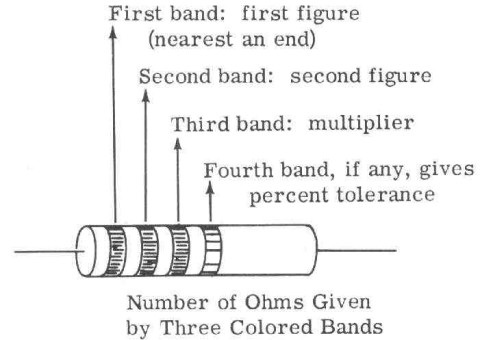Resistor Colour Codes
- Black = 0
- Brown = 1
- Red = 2
- Orange = 3
- Yellow = 4
- Green = 5
- Blue = 6
- Violet = 7
- Gray = 8
- White = 9
- Gold = .1
- Silver = .01
Tolerance Band
- Gold = ±5%
- Silver = ±10%
- unmarked = ±20%
All electrical and electronic components use resistors. In fact, resistors are one of the main components in electronics! In this activity we will learn how to read the resistor colour code.
The amount of resistance is measured in units called ohms (the symbol for an Ohm looks kind of like a horseshoe with feet on the ends). “Ohm” is pronounced like “home” with “h” the left off. A higher resistance results in lower current flow, much like the tighter you squeeze a garden hose, the slower the water comes out. Resistors can often have thousands or millions of ohms of resistance. Below are the most common units.
| 1 Ohm | = | 1 Ohm |
| 1,000 Ohms | = | 1K (Kilo) Ohm |
| 1,000,000 Ohms | = | 1M (Mega) Ohm |
Resistors used in electronic circuits are usually so small, it would be hard to mark the resistance so that you could read the value easily. Resistors use coloured bands to indicate both the value of the resistance and the tolerance (or “accuracy”). You must be able to decipher the code – fortunately for us, it’s easy! The tables below give the colors that code the value of a resistor.
The Colour Code
To use the resistor code, follow these steps (as an example, assume we have a resistor labeled Yellow, Violet, Red, Gold):
-
- Place the resistor in front of you with the tolerance band on your right
-
- The first colour on your left is the first digit
- (1 to 9)
(Yellow = 4
- )
-
- The second colour is the second digit
- (0 to 9) (
Violet = 7
- )
-
- The third colour indicates the number of zeros to add
- (0 to 6, -1, -2) (
Red = 2
- )
- (Gold, multiply by 0.1)
- (Silver, multiply by 0.01)
-
- The fourth colour is the tolerance
- (5 – 20%) (
Gold = ± 5%
- )
Therefore: a Yellow, Violet, Red, Gold resistor would be a 4 7 00 Ohms ± 5%
This can be written as 4700 Ohms, 4.7K Ohms, or 4K7 as well. The “K” is put in the decimal place.
A Brown, Black, Black, Gold resistor would be 10 Ohm ± 5%.
A Green, Black, Gold, Silver resistor would be 5.0 Ohms ± 10%.


